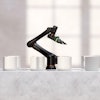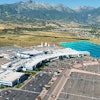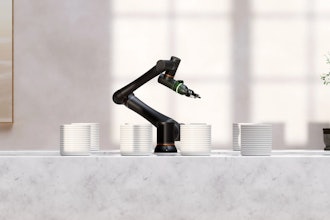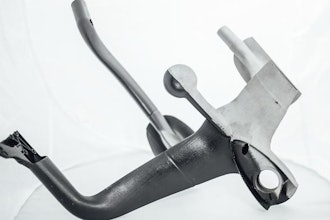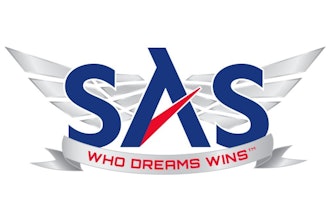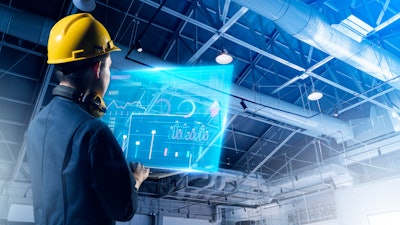
Economic uncertainties are pushing manufacturers to embrace emerging technologies as a means of staying competitive in a constantly evolving market. One example is augmented reality (AR). Deloitte’s 2023 manufacturing industry outlook reports that 12 percent of surveyed manufacturers plan to focus on AR in the coming year to improve operational efficiencies.
AR technologies enhance the physical world by superimposing digital information onto real-world objects and environments. Often AR displays are paired with gesture recognition to enable interaction with the AR environment. This creates an immersive experience that enhances the perception of and engagement with the real world.
AR can equip facility managers with real-time feeds indicating operating status and delivering production statistics. AR can assist industrial engineers by providing real-time notifications and alerts of potential maintenance issues, allowing for prompt and proactive resolution before they escalate into larger problems. Maintenance personnel can use AR to receive real-time guidance and step-by-step workflows during upkeep and repair operations, improving accuracy and minimizing downtime. Likewise, operators can use AR for training and ongoing guidance while operating equipment and machinery, reducing the risk of error and enhancing efficiency.
Over the last decade, patent applications that mention AR in either their title or abstract have grown from a few hundred applications per year to over a thousand. By examining patent filings, we can gain insight into how industrial manufacturers are utilizing AR technologies in their operations and achieving potential competitive advantages.
Obtaining a patent, however, can involve a significant investment and requires full disclosure of the invention. There is also no guarantee of securing meaningful patent protection, as the final outcome may be either no or limited protection. It is crucial to weigh the costs and benefits of revealing the details of an invention against the potential commercial value of any patent that might result, and the feasibility of enforcing patent rights against an infringer.
Recent AR Patents in Industrial Manufacturing
AR technologies are being used to enhance operations across entire manufacturing facilities. For instance, U.S. Patent No. 11,265,513, titled “Virtual Reality and Augmented Reality for Industrial Automation,” provides examples of AR systems that generate and deliver AR presentations to a user via a wearable device. These presentations include 3D “holographic views of a plant facility or a location within a plant facility,” which can be rendered based on the user’s current location or orientation on a facility floor.
The AR system “can provide automation system data, notification, and proactive guidance” by modifying the user’s view of the immediate surroundings. Additionally, the AR system can superimpose indicators near their corresponding machines, which can relate to “critical operating parameters” such as temperatures, pressures, speeds, and voltage levels, as well as “statistics or key performance indicators” such as “overall equipment effectiveness, performance or production efficiency, percentage of machine availability over time, product quality statistics, cycle times, overall downtime or runtime durations,” and more.
AR technologies are also being used to enhance maintenance operations. U.S. Patent No. 11,270,473, titled “Mechanical Fastening Unit Management Method Using Augmented Reality,” uses AR to aid operators in the proper tightening of fasteners. The AR-based system superimposes “a virtual space on a real space” to create an “an augmented reality space.” Within this AR space, virtual counterparts of a real-world fastening device, such as a torque wrench, and the real-world fasteners are presented. The AR system uses various visual cues such as colors, flashes, text, and graphics to indicate a proper tightening sequence, whether each fastener has received an appropriate amount of torque, and which fasteners still require tightening.
AR technologies have emerged as powerful tools for streamlining the handling of end products generated by this equipment. U.S. Patent No. 11,358,180, titled “Workpiece Collecting Point Units and Methods for Supporting the Processing of Workpieces,” describes using AR to improve the time-consuming and error-prone process of collecting, sorting, and arranging workpieces. With this system, an AR-equipped operator receives information indicating the appropriate sorting bins for the workpieces during a sorting process. During a collection process, the AR system can augment the display of a collection table to indicate the location of workpiece stacks of the same type and alert the operator when a stack of workpieces is complete.
U.S. Patent Application Publication No. 2022/0221845, titled “System and Method for Augmented Reality (AR) Assisted Manufacture of Composite Structures and Bonded Assemblies,” describes an AR-assisted system specifically designed for assembling the various layers of such structures and assemblies. These structures, which can include aircraft and vehicle panels, often possess complex geometries that necessitate precise placement during assembly. The AR system provides virtual representations of each layer of the structure and provides visual indicators that ensure accurate placement, position, and orientation of new layers relative to previously assembled layers.
The Right Tool for the Job?
Patents are not the only way to protect competitive advantages. Given the unique nature of manufacturing, innovators should carefully consider whether patents or alternative forms of intellectual property, such as trade secrets, are the most appropriate means of protecting their innovations. AR technologies often are employed in private within the confines of a manufacturing floor. The lack of visibility into whether a competitor is violating a patented invention can limit the effectiveness of the patent. The ability to detect infringement, therefore, is a key factor to consider when deciding whether to seek patent protection.
Potential commercial value is another important factor to consider. The examples above demonstrate that AR technologies may be tailored to suit the specific needs of a given facility, process, or end product. Understanding whether other manufacturers have similar needs can provide valuable insight into the potential market for the AR invention and help to assess the likelihood of competitors copying or licensing the invention. The expected commercial value of a patent, however, should be balanced against the potential costs to enforce it.
Defending one’s own innovations, however, is not the only motivation for applying for a patent. Other motivations include potential revenue streams via licensing, access to other technologies through cross-licensing opportunities or joint ventures, obtaining leverage in litigation, attracting investment through increased valuation, and providing access to funding by using patent assets as collateral. Ultimately, a combination of factors and motivations typically guide the decision to seek patent protection.
Manufacturers contemplating patenting their AR innovations should consult with an intellectual property attorney who can provide guidance on available options to safeguard those innovations and assist in crafting a strategy that aligns with specific business objectives.
Brian Emfinger is an IP attorney in Banner Witcoff’s Chicago office. His email is [email protected].

